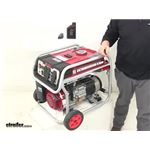A-iPower 4,500-Watt Portable Generator - 3,500 Running Watts - Gas - Manual Start

- All Info
- Q & A (0)
- Videos (2)
- Photos
A-iPower Generators - 289-SUA4500
- 4500 Starting Watts
- No Inverter
- Gas
- 120 Volt Output
- 240 Volt Output
- Recoil Start
- Wheels
- A-iPower
- 3500 Running Watts
- Not CARB Approved
Conventional generator supplies power for the job site or emergency situations. Keeps the lights on and appliances running during a power outage. Runs up to 11 hours on a half load. Wheels and a fold-down handle included.
Features:
- 4,500-Watt generator provides a portable power source
- Easy-start engine with recoil handle offers reliable startup
- A-iPower 4-stroke engine uses standard unleaded gas - no need to mix gas and oil
- Voltage selector switch provides 120V or 240V usage on L14-30R twist-lock outlet
- Digital hour meter helps you keep track of how long the generator is running
- Warning indicators, voltage regulator, and spark arrestor promote accident-free use
- Fold-down handle and 7" flat-free wheels provide easy mobility
- Strong, tubular steel frame
- Clean-running engine meets EPA standards
Specs:
- Outlets:
- (4) 120V 20-amp
- (1) 120V/240V 30-amp L14-30R
- Starting (surge) power output: 4,500 watts
- Running (rated) power output: 3,500 watts
- Continuous run time:
- At rated load: 7.5 hours
- At 1/2 load: 11 hours
- Noise level (normal conversation is 60 dB):
- Measured at 23' away: 68 dB
- Engine type: A-iPower 208-cc, single cylinder, air-cooled, 4-stroke OHV
- Horsepower: 7
- Fuel type: gasoline
- Capacity: 4 gal
- Oil type: SAE 10W-30
- Capacity: 0.63 qt
- Power line frequency: 60 Hz
- Dry weight: 111 lbs
- Dimensions: 24-1/2" long x 22-13/16" wide x 22-5/8" tall
- Warranty:
- 2-Year warranty for residential use
- 1-Year warranty for commercial use
Includes:
- 30-Amp RV adapter
- Wheel kit
- Engine oil
- Spark plug socket
Notes:
- This generator is not legal for sale or use in the state of California.
- Gas generators produce carbon monoxide, which is poisonous. For your safety, always be sure to operate this gas-powered generator outdoors.
- Because this generator does not have a built-in inverter to control the electrical current, the voltage can fluctuate. Therefore, do not plug sensitive electronic devices such as a computer or television into the generator.
Certifications
Meets the following important certification standards:
- US Environmental Protection Agency (EPA)
High-Output Capacity

The A-iPower SUA4500 generator produces 4,500 watts of power to get you up and running whether you're at the campsite, at the worksite, or faced with an emergency. This powerful generator comes with (4) 120V outlets for safely powering household items such as refrigerators, televisions, fans, lights, and tools. It also features (1) 120V/240V 30-amp L14-30R twist-lock outlet that provides a connection point for an inlet box used in home backup power. The generator also has outlet covers to help keep out moisture and debris.
Easy-Start Engine
This generator features a recoil pull handle that provides easy manual startup. It uses standard unleaded gas, so there is no need to mix gas and oil.
Before starting your generator, ensure nothing is connected to the outlets. Start your generator and let the engine run for a few minutes to warm up and stabilize. Once the generator is up and running, follow the recommended order of operation: connect the device with the highest starting watts first, like your air conditioner or refrigerator, then work your way down to the device with the lowest starting watts. By connecting devices in this order, you'll ensure the generator has enough power to start high-wattage loads.
Safety Features
This generator comes with a number of safety features to protect you, the environment, and the generator itself. When the generator is low on oil, a light-up indicator flashes and the engine will automatically shut down to prevent damage. If an overload is detected, either by exceeding the generator's limits or a power surge, the circuit breaker will stop supplying power to the connected devices. The automatic voltage regulator assists in minimizing voltage fluctuations which helps to maintain a steady flow of electricity. Also, a built-in spark arrestor helps prevent any sparking that might burn someone or start a fire. This arrestor has been certified by the USDA Forest Service.
Choosing a Generator
When choosing a generator, you need to match the generator's starting and running output with the electrical demands of the equipment you want to operate.
Power Demands
Starting (surge) wattage is the power a device requires at startup. Running (rated) wattage is the power needed to keep the device running. A large appliance with an electric motor such as a furnace, refrigerator, air conditioner, or washing machine may require 2 to 3 times more starting wattage than running wattage.
It is always best to start your generator with no load connected, then add each device one at a time. Additionally, a good practice to consider is connecting your devices in order from highest starting watts to lowest starting watts. As you connect and start devices, your available wattage decreases. This order of operation allows you to start devices with the highest power demands when there is more power available.
Will This Generator Run My RV Air Conditioner?
At etrailer, we perform numerous tests on generators that put them through real-world experience. An extensive part of this testing includes starting and running RV air conditioners. The following table will help you decide if the e3200 inverter generator has enough power to handle this critical function in your RV.
| Air Conditioner | Will it start and run? |
|---|---|
| Single 13,500 Btu | Yes |
| Single 15,000 Btu | Yes |
| Dual 15,000 Btu | Yes |
Running Watts and Starting Watts of Common Appliances
| Appliance | Running Watts | Starting Watts |
|---|---|---|
| Air compressor (1/2 hp) | 1,000 | 2,000 |
| Air conditioner (15,000 Btu) | 1,600 | * |
| Air conditioner (13,500 Btu) | 1,300 | * |
| Air conditioner (10,000 Btu) | 1,000 | * |
| Blender | 400 | 850 |
| Cell phone charger | 11 | 0 |
| Clock radio | 4 | 0 |
| Coffee maker (high setting) | 1,066 | 0 |
| Crock pot (low setting) | 126 | 0 |
| Crock pot (high setting) | 374 | 0 |
| Desktop computer | 150 - 350 | 0 |
| DVD player | 14 | 0 |
| Electric drill (3/8" / 4 amps) | 450 | 600 |
| Electric space heater (high setting) | 1,450 | 0 |
| Floor fan | 100 | 0 |
| Hair dryer (low setting) | 160 | 0 |
| Hair dryer (high setting) | 1,300 | 0 |
| LCD television (32") | 68 | 0 |
| Microwave | 1,000 | 0 |
| Refrigerator | 800 | 1,600 |
| Washing machine | 1,150 | 2,250 |
| Work light (quartz halogen) | 1,000 | 0 |
* The starting wattage on air conditioners can vary greatly depending on several factors, including the assistance of built-in capacitors and cold starts. Because of this, we can't list a standard starting wattage as every application can be different.
Determining Your Power Needs
The following section provides calculations for wattage estimates. This will give you an overall picture of your potential power usage and help you decide on the generator that is right for you.
Industry Standard Calculation
The Industry Standard Calculation is a quick and easy way to determine your required wattage. It may provide some padding in your wattage requirements, which could give you more power than you actually need, but you shouldn't have to worry about not having enough power. The following steps will help you quickly calculate the correct size generator to meet your application.
As stated earlier, you should always start your generator without any load, and then connect each device one at a time. The following calculation requires this approach to work. However, using this calculation removes the worry of connecting devices in a certain order.
1. Determine the starting watts and running watts for the devices that you want to plug into the generator.
a. Find the starting (surge) watts and running (rated) watts for each device that you want to plug into the generator. Look for a sticker or plate on each device or check your owner's manuals.
b. If your device or manual only shows amps and volts, watts can also be determined through a simple formula. (Amps x Volts = Watts)
c. List all of your starting watts and running watts as seen in Table 1 below.
Table 1
| Example Devices | Starting Watts | Running Watts |
|---|---|---|
| Air compressor | 2,000 | 1,000 |
| Refrigerator | 1,600 | 800 |
| Microwave | 0 | 1,000 |
| Blender | 850 | 400 |
2. To find the total starting watts required, add the starting watts for the device with the highest value to the running watts of all the other devices from Table 1.
2,000 + 800 + 1,000 + 400 = 4,200 total starting watts
3. To find the total running watts, add all of the running watts together from Table 1.
1,000 + 800 + 1,000 + 400 = 3,200 total running watts
To run all of these devices simultaneously, you would require a generator with at least 4,200 starting watts and 3,200 running watts.
Advanced, Precise Calculation
While the method for calculating your power needs outlined above will work, it isn't the most precise. If you aren't afraid of doing a little more math, you can use the Advanced, Precise Calculation to get a more accurate idea of how much power you will need and potentially save yourself some money. Because the calculation above pads in enough power to ensure you can start your devices in any order, it may point you to a bigger and more expensive generator than you need. However, by following the more regimented, order-of-operations calculation below, you'll get a much more precise idea of how much power you need, which could in turn point you to a smaller and less expensive generator.
Again, you should always start your generator without any load, and then connect each device one at a time. The following calculation also requires that you start your devices in order from highest starting watts to lowest starting watts. When you connect devices in this order, you can start high demand devices when there is more power available.
1. Determine the starting watts and running watts for each device that you want to plug into the generator.
a. Find the starting (surge) watts and running (rated) watts for each device that you want to plug into the generator. Look for a sticker or plate on each device or check your owner's manuals.
b. If your device or manual only shows amps and volts, watts can also be determined through a simple formula. (Amps x Volts = Watts)
c. List out these devices from highest starting watts to lowest starting watts as seen in Table 2 below.
Table 2
| Example Devices | Starting Watts | Running Watts |
|---|---|---|
| Air compressor | 2,000 | 1,000 |
| Refrigerator | 1,600 | 800 |
| Microwave | 0 | 1,000 |
| Blender | 850 | 400 |
2. To find the total running watts, add all of the running watts together from Table 2.
1,000 + 800 + 1,000 + 400 = 3,200 total running watts
3. In Table 3, shown below, the values from Table 2 are used to calculate the highest total starting watts required as devices are connected and running. This number represents the highest power requirement you will encounter as you connect all of your devices to the generator. To find this, add the starting watts of each new device you connect to the combined running watts of all connected devices. The highest of these numbers will be the total starting watts required. And again, remember to always connect devices in order from highest starting watts to lowest starting watts.
Table 3
| Device | Starting Watts | Running Watts of All Connected Devices | Total Starting Watts Required |
|---|---|---|---|
| 1. Air compressor | 2,000 + | 0 (nothing connected) | = 2,000 |
| 2. Refrigerator | 1,600 + | 1,000 (air compressor) | = 2,600 |
| 3. Microwave | 1,000* + | 1,800 (air compressor + refrigerator) | = 2,800 |
| 4. Blender | 850 + | 2,800 (air compressor + refrigerator + microwave) | = 3,650 |
* Even though the microwave does not have starting watts listed, you have to account for the power needed to actually run it.
850 + 2,800 = 3,650 highest total starting watts required
In order to run all of these devices simultaneously, you would require a generator with at least 3,650 starting watts and 3,200 running watts.
SUA4500 A IPower Portable Generator - 4,500 Watts - 120V/240V - Portable - Gas
Installation DetailsCalifornia residents: click here


Videos are provided as a guide only. Refer to manufacturer installation instructions and specs for complete information.
Video Transcript for A-iPower 4500-Watt Portable Generator Review
Hey, guys. Today we're gonna be checking out the A-iPower 4,500-Watt Generator. Now this is a conventional generator. It takes gasoline. Let's go ahead and fire it up, and see what it sounds like. As you can see with it fired up, it is a little bit noisier, but it's gonna provide us with the power that we need.
It's gonna be great for camping, at the job site, or in emergency situations. I'm gonna go ahead and plug in my camper, and we'll step inside.So here I am inside my camper. My generator is right outside, and I can honestly say it's still fairly loud. I'll give you a chance to hear it. So right there is you may have been able to hear it, it's definitely louder compared to an inverted generator.
Inverted generators are generally encased, which helps cut down on some of that noise. But what's different about this generator is, is it's a lot more powerful. We're gonna be able to run our larger appliances like our AC, our washer and dryer, and our microwave.But when choosing a generator, it's important that you choose one that's gonna meet your electrical demands. Some things to consider are you're starting watts and your running watts. Starting watts is power required by that device when it's first turning on, and running watts is power required to keep that device running continuously.
Some things like your AC, your microwave, your washer and dryer, things like we just talked about, may require up to two to three times more power when first turning on, than to continuously run. Again, you just wanna be sure you choose a generator that's gonna meet your electrical demands. What this means is that when they turn on, the power will spike, and then drop to a lower wattage when it continuously runs. An example might be when you're home, and you turn on the vacuum cleaner, and the lights dim. Another way to look at it is water pressure.
When you're in the shower, and somebody flushes the toilet, the water pressure drops.Another thing to consider is how many of these devices you'll be running simultaneously. It all adds up. Let's go ahead and take a step back outside and take a closer look. Now coming out of my camper, again, it's a noisy generator. This is the type of generator you'd wanna place as far away from your campsite, your RV, or your job site, to really help cut down on some of that noise. As I'm walking towards you, you can see how that noise is gonna drop. This'll give you an idea of how maybe far away you need to place it.Now I mentioned earlier that it's a conventional generator. This is more of your traditional style. It's a gas-powered motor that is attached to an alternator that generates AC power. Though the problem is with this generator is it's power fluctuates, so it's gonna be unsafe to use with sensitive electronics, things like TVs, computers, and phones. You won't be able to plug any of those items directly into it. But the reason you can use this generator on an RV or camper that has those sensitive items in it, is because your RV and camper converts that power down to a safe working limit, like 120-volt down to 12-volt.All in all, the benefit here is this style of generator is more powerful. Powerful enough to run your house or multiple appliances within your house. You only need one of these generators, whereas you may need two inverted generators to produce that power. This one offers 4,500 starting watts, and 3,500 running watts.Now onboard is pretty easy. It offers four common household outlets. Over here we have 120-volt, or 240-volt twist-lock outlet. This would be great for using maybe a large compressor or a welder. Right here we have our circuit breakers. Should we blow those, simply push to reset. On over here, we've got our run-time in hours. We've got out voltage switch from 120 to 240, depending on what you're using for that twist-lock. And then right here we have our on switch and our kill switch.Now here on top we have our fuel gauge, so we can keep an eye on where we're at when we're operating it. We also have our fuel cap. Now it does hold four gallons. This is another plus compared to inverted generators. Those tend to only hold around a gallon, whereas this one holds four. We don't need to worry about refilling it as much.Now it is a four-stroke motor. It takes regular gasoline, so we don't need to worry about any mixture. You do however have to monitor your oil. Now to give you an idea of how long it'll run for, if you're running it at a full load, maybe with some heavy-duty appliances or tools, when you're running it at a full load, you can be right around about seven-and-a-half hours it'll run. Now if you're running at half load, we're looking at about 11 hours. So just keep that in mind.Now this generator weighs around 111 pounds. That's pretty heavy. That's its dry weight too. That's without gasoline and oil. That's one downside to this type of generator. Inverted generators are smaller, and they have a nice, easy handle on top so we can carry it wherever we need it to be. If you're trying to load this on your truck bed, I recommend getting a second set of hands.It is however portable. That way we can get it to where we need it to be. The handle comes up, and we've got wheels. When it comes to maintaining your generator, everything is easily accessible. We don't need to worry about removing any panels like we do with an inverted generator. We have our spark plug here, and the tool is included to remove that. We have our choke for when we're getting ready to start it. Our air filter is located behind this here. Here on the opposite side, we have our fuel shutoff, for when it's not in use, and down here we have our oil cap. The exact amount of oil is included to fill it up. You'll wanna be sure and do that before you try and start it, of course.When it comes to storing the generator, it is rather large, so I'll give you some dimensions. They're 24-1/2" long, 22-13/16" wide, and 22-5/8" tall. You wanna keep these in mind for when you wanna maybe store it in one of your RV or camper's compartments.Now in case you're unfamiliar with how to start a generator, or you missed it in the beginning of the video, I'll go ahead and show you how to start it up. First, you wanna make sure that the engine switch is turned to the on position. You wanna be sure the choke is in the choke position. You'll also wanna be sure that your fuel line is in the on position. After that, we can pull on the pull cord. Once it gets started to where it's gonna run, turn that choke to the run position, and then you're ready to go.
See what our Experts say about this A-iPower Generators
- Can A-iPower 4,500-Watt Portable Generator Power 15 Amp AccessoryThis does have 30 amps at a 30 amp outlet. If you have more amperage than needed for an accessory like in the scenario you described where a 30 amp outlet is powering a 15 amp accessory you are totally fine. 30 amp outlets have 30 amps on two of the pins of the outlet but instead of having 240 at each pin there's 120 at on each. Here's the times this can run. Continuous run time: At rated load: 7.5 hours At 1/2 load: 11 hours
view full answer... - Smallest Inverter Generator with 240 Volt 50 Amp OutletThe smallest (in regards to watts) generator that we offer with a 240 volt outlet is the A-iPower 4,500-Watt Portable Generator part # 289-SUA4500. That said, this generator does not come with an inverter nor do we offer an inverter generator with a 240 volt outlet. However, you could use an inverter generator like the etrailer 3,200-Watt Portable Inverter Generator part # 333-0003 or one from the list below with a 240 volt plug but you would also need an adapter the Mighty Cord RV Power...
view full answer...
Do you have a question about this Generator?
Info for this part was:







At etrailer.com we provide the best information available about the products we sell. We take the quality of our information seriously so that you can get the right part the first time. Let us know if anything is missing or if you have any questions.






















































Thank you! Your comment has been submitted successfully. You should be able to view your question/comment here within a few days.
Error submitting comment. Please try again momentarily.